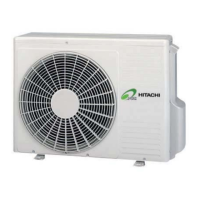REFRIGERANT PIPING & REFRIGERANT CHARGE
21
11.4. BRAZING WORK
µ ATTENTION:
Use nitrogen gas for blowing during pipe brazing. If
oxygen, acetylene or fluorocarbon gas is used, it will
cause an explosion or poisonous gas.
A lot of oxidation film will occur inside of tubes if no
nitrogen gas blowing is performed during brazing
work. This film will be flecked off after operation and
will circulate in the cycle, resulting in clogged
expansion valves, etc. This will cause bad influence
to the compressor.
Use a reducer valve when nitrogen gas blowing is
performed during brazing. The gas pressure should
be maintained within 0.03 to 0.05Mpa. If a
excessively high pressure is applied to a pipe, it will
cause an explosion.
11.5. REFRIGERANT CHARGE
CAUTION:
Do not charge OXYGEN, ACETYLENE, or other
flammable and poisonous gases into the refrigerant
because an explosion can occur. It is recommended
that oxygen free nitrogen be charged for these types
of tests cycle when performing a leakage test or an
airtight test. These types of gases are extremely
dangerous,
Insulate the unions and flare-nuts at the piping
connection part completely.
Insulate the liquid piping completely to avoid a
decrease of performance; if not, it will cause sweating
on the surface of the pipe.
Charge refrigerant correctly. Overcharging or
insufficient charging could cause a compressor
failure.
Check for refrigerant leakage in detail. If a large
refrigerant leakage occurred, it would cause difficulty
with breathing or harmful gases would occur if a fire
were being used in the room.
If the flare nut mut is tigthened too hard, the flare nut
may crack after a long time and cause refrigerant
leakage.
11.6. REFRIGERANT CHARGING QUANTITY
Outdoor Units has been charged with refrigerant for 30m of
actual piping length. An additional refrigerant charged is
required in systems with actual piping length longer than
30m.
1. Determine an additional refrigerant quantity according to
the following procedure, and charge it into the system.
2. Record the additional refrigerant quantity to facilitate
service activities thereafter.
CAUTION:
When charging refrigerant accurately measure
refrigerant to be charged.
Overcharging or undercharging of refrigerant ca

